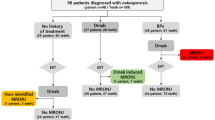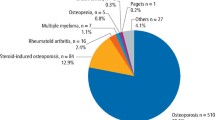Abstract
Medication-related osteonecrosis of the jaw (MRONJ) is a severe adverse event, most commonly associated with dental extractions as a predisposing event. However, it is possible that established MRONJ may be existent before dental extractions and is mistaken for odontogenic disease. The provision of a dental extraction will lead to clinically obvious MRONJ with the cause being attributed to tooth removal. We present a case series of ten patients with pre-existing necrosis of the jaw before dental extraction.
Retrospective data were collected on ten patients who presented to the oral surgery department between 2017-2021, diagnosed with pre-existing necrosis. A diagnosis of pre-existing MRONJ was made based on the identification of necrotic bone clinically, either with plain film or cone beam computed tomography (CBCT). Patients with pre-existing necrosis presented with a range of symptoms, including pain, swelling and tooth mobility. Plain film imaging revealed a variety of findings, including periapical radiolucency, periodontal ligament widening and bone loss. CBCT imaging confirmed a necrotic pattern of bone destruction confirming a diagnosis of pre-existing MRONJ.
There is increasing evidence to suggest that local inflammation can be a predisposing factor for MRONJ development as opposed to surgical intervention. This case series provides early insight into the presentation of pre-existing MRONJ.
Key points
-
Highlights that medication-related osteonecrosis of the jaw can be pre-existing prior to dental extractions.
-
Provides support and evidence that the provision of dental extractions by the general dental practitioner is not always the causative intervention for medication-related osteonecrosis of the jaw.
-
Proposes the evidence for pre-existing medication-related osteonecrosis of the jaw and how to identify it.
This is a preview of subscription content, access via your institution
Access options
Subscribe to this journal
Receive 24 print issues and online access
$259.00 per year
only $10.79 per issue
Buy this article
- Purchase on Springer Link
- Instant access to full article PDF
Prices may be subject to local taxes which are calculated during checkout




Similar content being viewed by others
References
Scottish Dental Clinical Effectiveness Programme. Oral Health Management of Patients at Risk of Medication-related Osteonecrosis of the Jaw. 2017. Available at https://www.sdcep.org.uk/published-guidance/medication-related-osteonecrosis-of-the-jaw/ (accessed October 2023).
Coleman R, Body J J, Aapro M, Hadji P, Herrstedt J. Bone health in cancer patients: ESMO Clinical Practice Guidelines. Ann Oncol 2014; 25: 124-137.
Ruggiero S L, Dodson T B, Aghaloo T, Carlson E R, Ward B B, Kademani D. American Association of Oral and Maxillofacial Surgeons' Position Paper on Medication-Related Osteonecrosis of the Jaws - 2022 Update. J Oral Maxillofac Surg 2022; 80: 920-943.
Bhula S, Mallya S, Tetradis S. The role of imaging in MRONJ: An evidence based, institutional experience. Oral Surg Oral Med Oral Pathol Oral Radiol 2020; 130: 58-59.
Marx R E. Pamidronate (Aredia) and zoledronate (Zometa) induced avascular necrosis of the jaws: a growing epidemic. J Oral Maxillofac Surg 2003; 61: 1115-1117.
European Medicines Agency. Xgeva: Summary of product characteristics. Available at https://www.ema.europa.eu/en/documents/product-information/xgeva-epar-product-information_en.pdf (accessed March 2023).
European Medicines Agency. Zometa: Summary of product characteristics. Available at https://www.ema.europa.eu/en/documents/product-information/zometa-epar-product-information_en.pdf (accessed March 2023).
Royal College of Physicians. Medication-related osteonecrosis of the jaw: guidance for the oncology multidisciplinary team. 2019. Available at https://www.rcplondon.ac.uk/guidelines-policy/medication-related-osteonecrosis-jaw-guidance-oncology-multidisciplinary-team (accessed March 2023).
Ikesue H, Doi K, Morimoto M et al. Switching from zoledronic acid to denosumab increases the risk for developing medication-related osteonecrosis of the jaw in patients with bone metastases. Cancer Chemother Pharmacol 2021; 87: 871-877.
Ehrenstein V, Heide-Jørgensen U, Schiødt M et al. Osteonecrosis of the jaw among patients with cancer treated with denosumab or zoledronic acid: results of a regulator-mandated cohort postauthorization safety study in Denmark, Norway, and Sweden. Cancer 2021 127: 4050-4058.
McGowan K, McGowan T, Ivanovski S. Risk factors for medication-related osteonecrosis of the jaws: A systematic review. Oral Dis 2018; 24: 527-536.
Nicolatou-Galitis O, Schiødt M, Mendes R A et al. Medication-related osteonecrosis of the jaw: definition and best practice for prevention, diagnosis, and treatment. Oral Surg Oral Med Oral Pathol Oral Radiol 2019; 127: 117-135.
Kamimura M, Taguchi A, Komatsu M et al. Long waiting time before tooth extraction may increase delayed wound healing in elderly Japanese. Osteoporos Int 2018; 30: 621-628.
Chang J, Hakam A E, McCauley L K. Current Understanding of the Pathophysiology of Osteonecrosis of the Jaw. Curr Osteoporos Rep 2018; 16: 584-595.
Barasch A, Cunha-Cruz J, Curro F A et al. Risk factors for osteonecrosis of the jaws: a case-control study from the CONDOR dental PBRN. J Dent Res 2011; 90: 439-444.
Otto S, Pautke C, Martin Jurado O et al. Further development of the MRONJ minipig large animal model. J Craniomaxillofac Surg 2017; 45: 1503-1514.
Bolette A, Lecloux G, Rompen E, Albert A, Kerckhofs G, Lambert F. Influence of induced infection in medication-related osteonecrosis of the jaw development after tooth extraction: A study in rats. J Craniomaxillofac Surg 2019; 47: 349-356.
Aguirre J I, Akhter M P, Kimmel D B et al. Oncologic doses of zoledronic acid induce osteonecrosis of the jaw-like lesions in rice rats (Oryzomys palustris) with periodontitis. J Bone Miner Res 2012; 27: 2130-2143.
Otto S, Tröltzsch M, Jambrovic V et al. Tooth extraction in patients receiving oral or intravenous bisphosphonate administration: A trigger for BRONJ development? J Craniomaxillofac Surg 2015; 43: 847-854.
Saia G, Blandamura S, Bettini G et al. Occurrence of bisphosphonate-related osteonecrosis of the jaw after surgical tooth extraction. J Oral Maxillofac Surg 2010; 68: 797-804.
Nicolatou-Galitis O, Papadopoulou E, Vardas E et al. Alveolar bone histological necrosis observed before extractions in patients, who received bone-targeting agents. Oral Dis 2020; 26: 955-966.
Hadaya D, Soundia A, Gkouveris I, Dry S M, Aghaloo T L, Tetradis S. Development of Medication-Related Osteonecrosis of the Jaw After Extraction of Teeth With Experimental Periapical Disease. J Oral Maxillofac Surg 2019; 77: 71-86.
Yarom N, Fedele S, Lazarovici T S, Elad S. Is exposure of the jawbone mandatory for establishing the diagnosis of bisphosphonate-related osteonecrosis of the jaw? J Oral Maxillofac Surg 2010; 68: 705.
Bedogni A, Fedele S, Bedogni G et al. Staging of osteonecrosis of the jaw requires computed tomography for accurate definition of the extent of bony disease. Br J Oral Maxillofac Surg 2014; 52: 603-608.
Ogura I, Minami Y, Ono J et al. CBCT imaging and histopathological characteristics of osteoradionecrosis and medication-related osteonecrosis of the jaw. Imaging Sci Dent 2021; 51: 73-80.
Badabaan G M, Singer S R, Creanga A G, Strickland M. Systematic review of cone beam computed tomography use in diagnosis of medication-related osteonecrosis of the jaw. Oral Surg Oral Med Oral Pathol Oral Radiol 2020; 130: 68-69.
Shimamoto H, Grogan T R, Tsujimoto T et al. Does CBCT alter the diagnostic thinking efficacy, management and prognosis of patients with suspected Stage 0 medication-related osteonecrosis of the jaws? Dentomaxillofac Radiol 2018; 47: 20170290.
Author information
Authors and Affiliations
Contributions
Vinod Patel: conceptualisation, manuscript preparation and manuscript review. Mariam Al-Sarraj and Megan Burns: data curation, data analysis, manuscript preparation and manuscript review.
Corresponding author
Ethics declarations
The authors declare no conflicts of interest.
Ethical approval and consent to participate was not required for this retrospective clinical case series.
Rights and permissions
Springer Nature or its licensor (e.g. a society or other partner) holds exclusive rights to this article under a publishing agreement with the author(s) or other rightsholder(s); author self-archiving of the accepted manuscript version of this article is solely governed by the terms of such publishing agreement and applicable law.
About this article
Cite this article
Al-Sarraj, M., Burns, M. & Patel, V. Pre-existing medication-related osteonecrosis of the jaw before dental extraction. Br Dent J 235, 783–788 (2023). https://doi.org/10.1038/s41415-023-6447-8
Received:
Revised:
Accepted:
Published:
Issue Date:
DOI: https://doi.org/10.1038/s41415-023-6447-8



